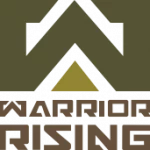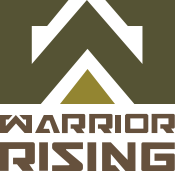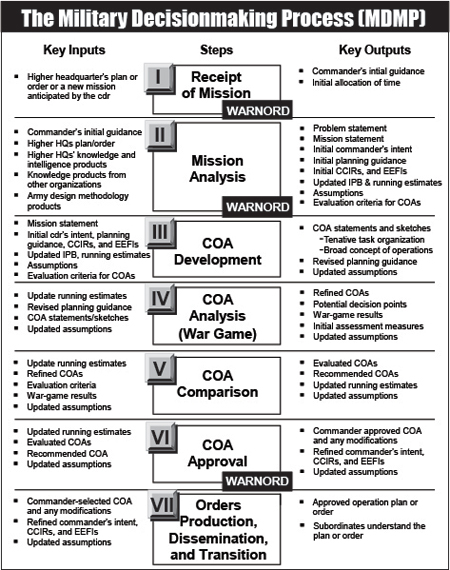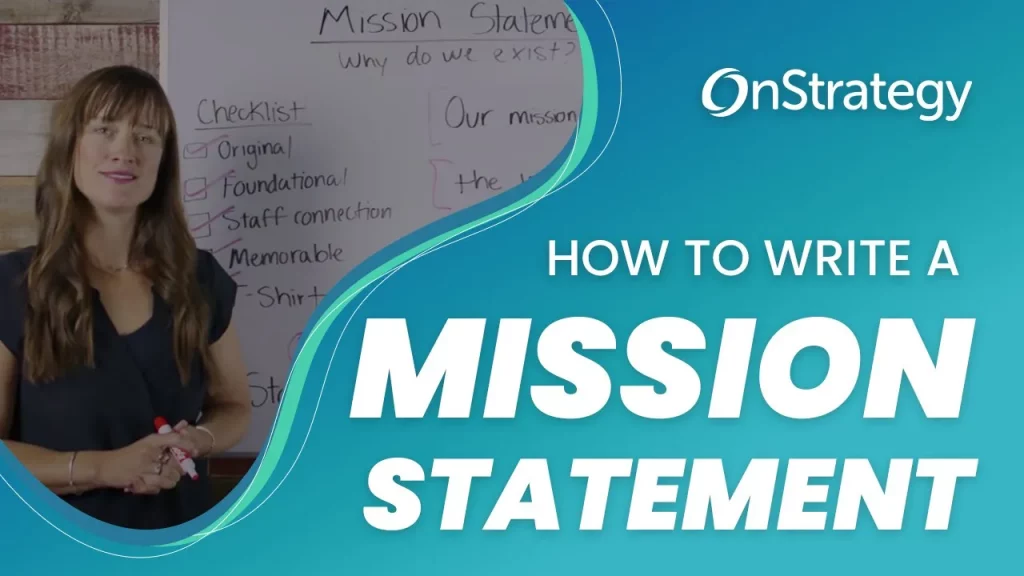
52 Mission Statement Examples that Rock + Free Mission Guide
In this article, we will define ‘what is a mission statement’, briefly highlight the essentials of creating a strong mission statement and show you some of the best mission statement examples from top organizations around the world.
What is a mission statement and its purpose?
Remember that a mission statement explains why your organization exists. It is a foundational element of your plan that establishes your core purpose and who you serve! A great mission statement stands the test of time, guiding more temporary and time-specific goals and plans. This, paired with a bold vision statement will serve as a strong foundation to your strategic plan.
For a mission statement to provide clarity, we recommend writing it with concrete language. We recommend avoiding abstract fluff that might sound good on the surface but does not help your team understand the “why” behind their work. We also recommend writing it in the present tense. This differentiates it from a vision statement, which is focused on the future. A mission statement should be timeless (or as close to it as possible). Writing it in the present tense helps capture that.
What are the benefits of a mission statement?
When it comes to strategic planning for your organization, you can’t underestimate the importance of having a clear and concise mission statement. Not only does it help provide direction and focus for your team and tells your customer base and community who you are and what you stand for. A well-crafted mission statement is the foundation for your overall strategy and decision-making.
By outlining your mission statement, you’re laying the groundwork for everything that follows. You’re setting the tone for your vision for your organization and the values you want to uphold. That can be a powerful tool for making decisions and setting priorities for the company’s future.
So, if you haven’t already drafted a mission statement, now is the time to start! It may take some time and thought, but the benefits will be well worth it in the long run.
What makes a great mission statement?
OnStrategy strongly believes in creating a mission statement that speaks to who you are and why you exist as an organization. We believe great mission statements should be audacious, motivating, and memorable.
This is because, as we’ve stated before, your mission statement reflects the best of you and serves as the foundation of your business or organization. Mission statements boldly state why you exist and do what you do – not only for your team and those doing the work but for your community and customers whose support you’re striving to capture.
We’ve crafted a mission statement cheat sheet that outlines the four criteria that every mission statement should meet:
Your mission statement should be foundational
Your mission statement should be original
All mission statements should be memorable
And bonus points if your mission statement is something you’d want represented on a t-shirt!
Pulling Together Your Mission Statement with the Help of OnStrategy’s Cheat Sheet [With Examples]
Check out our mission statement cheat sheet below for a downloadable guide to build your mission statement.
If you want to learn more on determining what is a mission statement that’s effective and how to write a mission statement that inspires, check out our guide!
Anatomy of an Effective Mission Statement
A mission statement is a powerful way to tell your board members, team and your customers who you are and why you exist – ideally in two sentences or less! Your company’s mission statement describes, essentially, your company’s core values and company’s purpose for existing today.
Maybe your organization believes that your business exists to provide outstanding customer service to all who walk through your door. Your employees will now know that your company’s identity revolves around providing the best customer service possible.
This process of creating a compelling mission statement may feel daunting, but don’t worry! By following our simple anatomy of a mission statement, you can easily put one together that truly defines your mission and purpose.
Every mission statement must have these five basic elements:
- A label such as, “Our mission…”
- A verb in the present tense.
- For whom you’re doing this for.
- A result or benefit of the work you do.
- What you do and how you do it.
For example, yours may end up looking like this: “Our mission is to make our clients successful by merging remarkable digital design and goal-focused usability.
Read our free canvas and guide for a deeper dive into the topic!
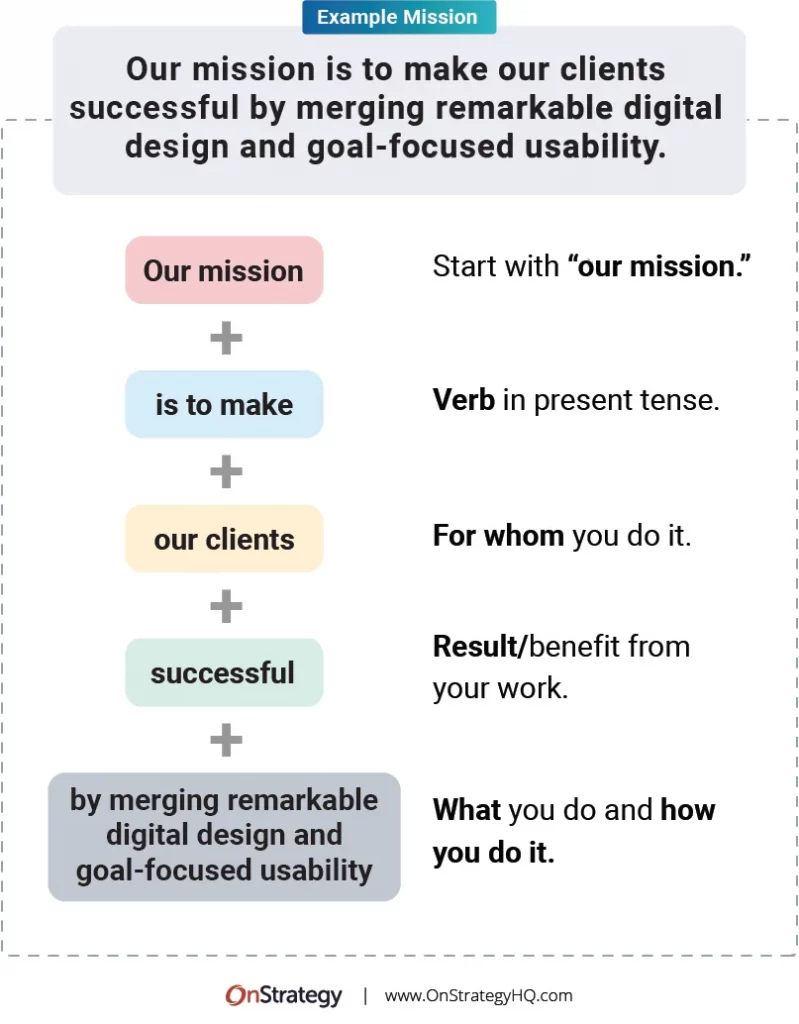
Mission Statement Versus Vision Statement Versus Values Statement: What’s the difference?
Vision Statement
A vision statement describes your clear vision of the future; your ambitions. Vision statements clearly state what your organization looks like in the future. Vision statement focuses on the big picture outcome, usually 5+ years in the future. [Check out our vision statement examples here.]
Mission Statements
A good mission statement clearly explains why you exist and what your organization’s purpose for existing is. A company mission statement also expressly states who you serve and how potential customers benefit from your work.
Values Statements
Values statements are an expression about how you expect your team to behave. They explain the values, beliefs, and experiences you expect to create within your organization.
Using Your Mission Statements, Vision Statements, and Values Statements Together
These three important plan elements aren’t meant to live as standalone items. They are designed to be used together! Mission and vision statements help your organization clearly articulate why you exist, who you serve, and where you’re going in the future. Your values statements help support your own mission and vision statment by expressing how you expect your organization to behave along the journey!
When in doubt, remember these three tips:
- Mission statement = why you exist.
- Vision statement = where you’re going in the future.
- Values statements = set of behaviors you expect from your team. you expect your team to behave.
When to know it’s time to update your mission statement?
As you move forward on your strategic planning process, maybe you’ve decided to revisit your mission statement. If you read it and thought, “Wait, that doesn’t really align with what we’re doing anymore, ” it may be time for an update. And that’s okay! It happens more often than you might think.
Your company constantly evolves and grows, so your mission statement must reflect those changes. Some signs that it’s time to hit refresh on your mission statement include:
- Huge shifts in your customer or target audience
- Major changes in your organization’s goals and approach
- A total rebrand
Remember, your mission statement should guide and inspire your business, so it’s essential to keep it relevant and meaningful! They have a shelf life of about 10-15 years.
A clear and concise mission statement can give your employees and customers a sense of direction and purpose. So, if you feel like your current mission statement is a little outdated or doesn’t reflect who you are as an organization, it might be time for a refresh.
Check out our 52 mission statement examples from some of the world’s best companies and organizations for inspiration!
52 Mission Statement Examples
Learning general principles for how to write a mission statement is helpful. However, these principles can become clearer by looking at some examples of mission statements. As you check out some of these mission statement examples from various types of organizations, notice how there are various ways to make your mission statement unique while sharing the tried-and-true principles of good mission statements:
Example Mission Statements for For-Profit Companies

Tesla: “Tesla’s mission is to accelerate the world’s transition to renewable energy.”
Starbucks“To inspire and nurture the human spirit- one person, one cup, and one neighborhood at a time.”
Coca-Cola: “The Coca-Cola Company exists to benefit and refresh everyone who is touched by our business.”
The Home Depot: “The Home Depot is in the home improvement business, and our goal is to provide the highest level of service, the broadest selection of products, and the most competitive prices.”
The Boeing Company, Africa Division: “Our mission is to establish a powerful presence and positive image of The Boeing Company with governments, businesses, and community leaders.”
Nike: “Our mission is to bring inspiration and innovation to every athlete* in the world. *If you have a body, you are an athlete.”
John Deere: “Double and Double Again the John Deere Experience of Genuine Value for Employees, Customers and Shareholders.”
Publix: “Our Mission at Publix is to be the premier quality food retailer in the world.”
Aveda: “Our mission at Aveda is to care for the world we live in, from the products we make to the ways in which we give back to society. At Aveda, we strive to set an example for environmental leadership and responsibility, not just in the world of beauty but around the world.”
General Motors: “General Motors’ corporate mission is to earn customers for life by building brands that inspire passion and loyalty through not only breakthrough technologies but also by serving and improving the communities in which we live and work around the world.”
New Leaf Paper: “The mission of New Leaf Paper is to be the leading national source for environmentally responsible, economically sound paper.”
Nordstrom: “Our mission is to continue our dedication to providing a unique range of products, exceptional customer service, and great experiences.”
Seventh Generation: “Seventh Generation is the nation’s leading brand of non-toxic and environmentally safe household products.”
Example Mission Statements for Non-Profits
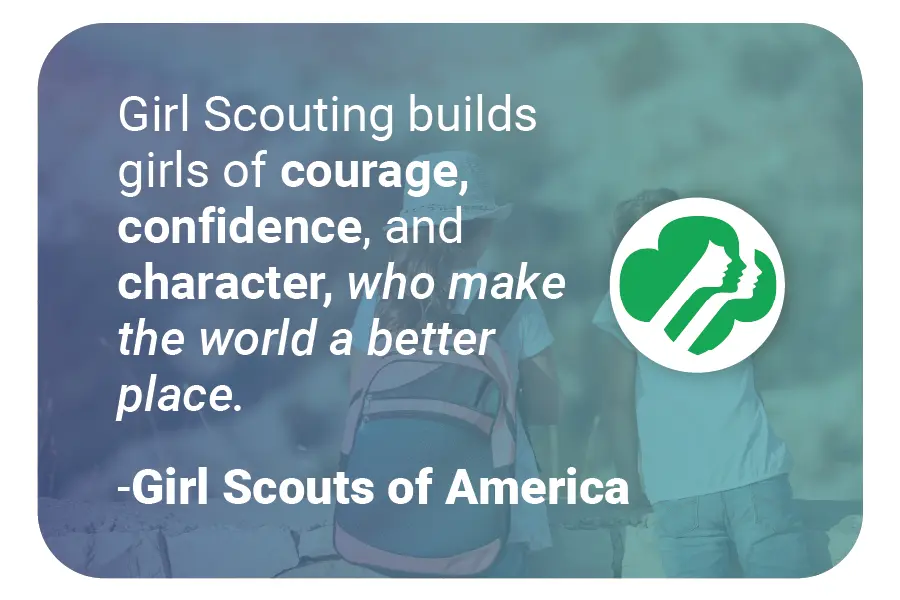
UNICEF: “UNICEF promotes the rights and well-being of every child, in everything we do.”
ACLU of San Diego: “To protect and expand fairness, equity, and freedom through community engagement, building power, policy advocacy, and impact litigation.”
Red Cross: “To provide compassionate care to victims of disasters.”
TED Talk: “Spread ideas. Make great ideas accessible and spark conversation.”
Girl Scouts of America: “Girl Scouting builds girls of courage, confidence, and character, who make the world a better place.”
Operation Underground Railroad: “We exist to rescue children from sex trafficking and sexual exploitation.”
Goodwill: “To enhance the dignity and quality of life of individuals and families by strengthening communities, eliminating barriers to opportunity, and helping people in need reach their full potential through learning and the power of work.”
Alzheimer’s Association: “Through our many initiatives and worldwide reach, the Alzheimer’s Association leads the charge in Alzheimer’s care, support, research and advocacy.”
Pioneer Center for the Performing Arts: “To cultivate exceptional performing arts experiences in our historic venue and throughout the region.”
Pioneer Center for the Performing Arts: “To cultivate exceptional performing arts experiences in our historic venue and throughout the region.”
ASPCA, The American Society for the Prevention of Cruelty to Animals:“To provide effective means for the prevention of cruelty to animals throughout the United States.”
Mission Statement Examples for Software Companies
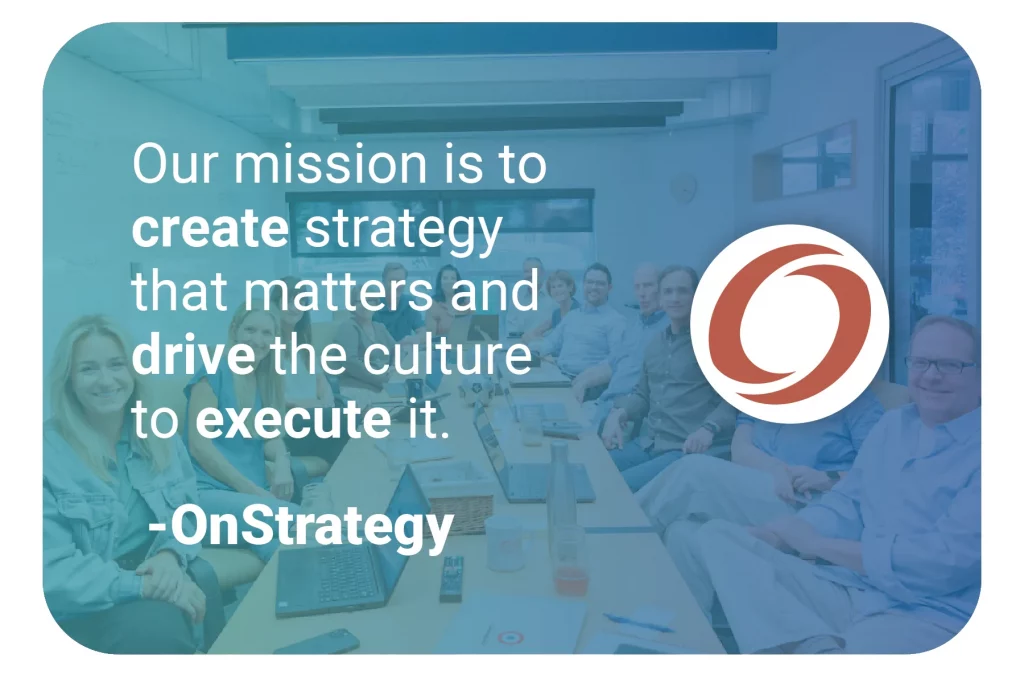
OnStrategy: “Our mission is to create strategy that matters and drive the culture to execute it.”
LinkedIn: “To connect the world’s professionals to make them more productive and successful.”
Equifax Business Services: “To serve our customers by utilizing information and technology that provide real-time answers to increasingly complex questions.”
Google: “To organize the world’s information and make it universally accessible and useful.”
Amazon: “We strive to offer our customers the lowest possible prices, the best available selection, and the utmost convenience.”
Duolingo: “We’re here to develop the best education in the world and make it universally available. Our global team works together to make language learning fun, free, and effective for anyone who wants to learn, wherever they are.”
Hulu: “To help people find and enjoy the world’s premium video content when, where and how they want it.”
Microsoft: “Our mission is to empower every person and every organization on the planet to achieve more.”
TikTok “ Our mission is to capture and present the world’s creativity, knowledge, and moments that matter in everyday life.”
Vivint: “Vivint helps families live intelligently in safer, smarter homes.”
Example Mission Statements for Healthcare Organizations
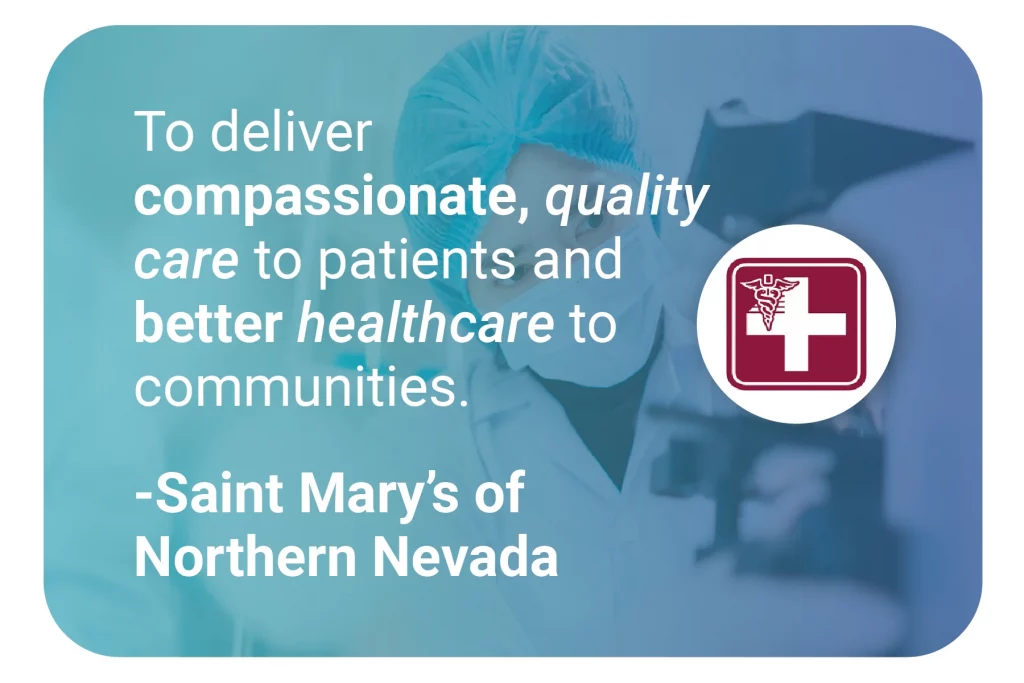
CVS: “Helping people on their path to better health.”
Saint Mary’s Regional Medical Center of Northern Nevada: “To deliver compassionate, quality care to patients and better healthcare to communities.”
Northern Nevada Hopes: “Our mission is to build a healthier community by providing affordable, high-quality medical, behavioral health, and support services for all.”
Pfizer Pharmaceuticals: “We will become the world’s most valued company to patients, customers, colleagues, investors, business partners, and the communities where we work and live.”
The WellPoint Companies: “The WellPoint Companies provide health security by offering a choice of quality branded health and related financial services designed to meet the changing expectations of individuals, families, and their sponsors throughout a lifelong relationship.”
New York-Presbyterian Hospital: “It is the mission of New York-Presbyterian Hospital to be a leader in the provision of world-class patient care, teaching, research, and service to local, state, national, and international communities.”
The Center for Disease Control: “CDC works 24/7 to protect America from health, safety, and security threats, both foreign and in the U.S. Whether diseases start at home or abroad, are chronic or acute, curable or preventable, human error or deliberate attack, CDC fights disease and supports communities and citizens to do the same.”
Valley OB/GYN: “At Valley OBGYN, we strive to provide quality comprehensive patient-centered women’s care here in Spokane Valley.”
The American Psychological Association: “Our mission is to promote the advancement, communication, and application of psychological science and knowledge to benefit society and improve lives.”
Dentistry for Children: “Dentistry for Children believes that good dental health starts in infancy. Our dedicated pediatric dentists and teen dental specialists promote cavity prevention and good dental habits to help create a positive experience at an early age and into their adolescent years.”
Mission Statement Examples for Governments and/or Government Entities
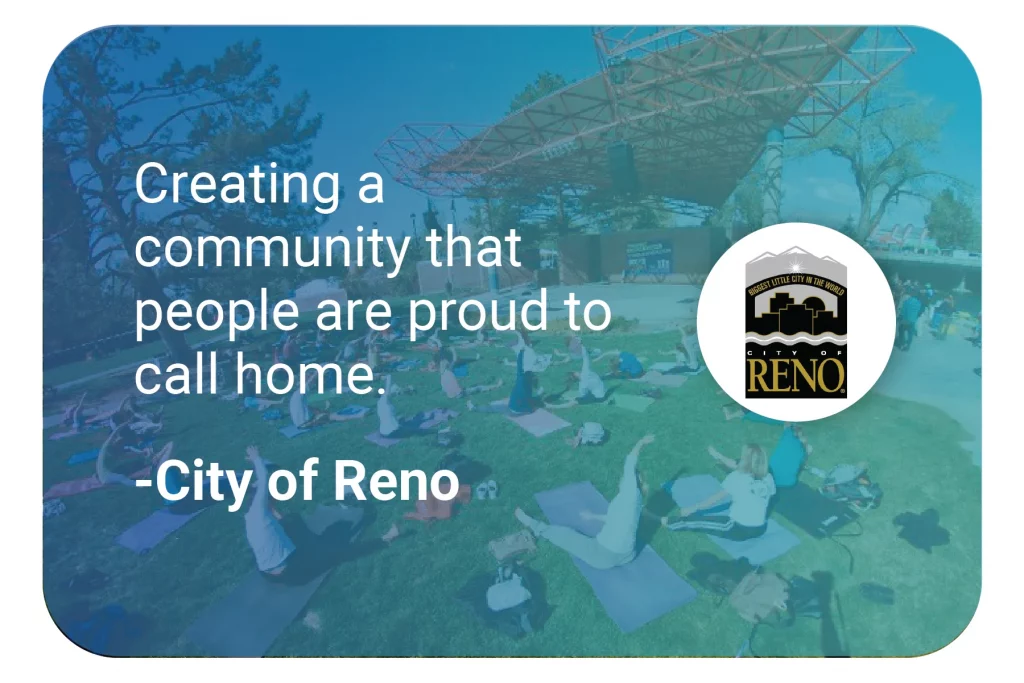
City of Windsor, Canada: “The City of Windsor, with the involvement of its citizens, will deliver effective and responsive municipal services, and will mobilize innovative community partnerships.”
Cliffside Park, New Jersey Police Department: “The Cliffside Park Police Department is committed to providing a safe and peaceful environment in the Borough of Cliffside Park through effective and impartial law enforcement.”
Fire Department New York: “As first responders to fires, public safety and medical emergencies, disasters, and terrorist acts, FDNY protects the lives and property of New York City residents and visitors. The Department advances public safety through its fire prevention, investigation, and education programs. The timely delivery of these services enables the FDNY to make significant contributions to the safety of New York City and homeland security efforts.”
Municipal Court of Lakeview, Texas: “Our mission is to provide an impartial, unbiased, fair, and respectful forum for the trials of all Class C misdemeanor Penal Code offenses, Health and Safety Code offenses, Alcoholic Beverage Code offenses, City Ordinance offenses, as well as to preside over administrative and civil proceedings, as authorized by state law.”
Albany, Georgia: “The City of Albany delivers fiscally responsible, highly dependable services to the citizens in the community and the region with integrity and professionalism.”
Chicago Public Library: “We welcome and support all people in their enjoyment of reading and pursuit of lifelong learning. Working together, we strive to provide equal access to information, ideas, and knowledge through books, programs, and other resources.”
Seattle, Washington City Clerk: “Provide consistent high-level services which promote and strengthen a world-class government prepared to meet the emerging needs of the 21st century. Ultimately, improving the quality of life for individuals (and the community at large) by being one of the top-tier local government agencies in our nation and by building on our interdisciplinary strengths.”
Michigan Civil Service Commission: “To provide innovative, effective, and timely HR consultation and services to attract, develop, and retain a workforce that is diverse, flexible, creative, and competent to meet the ever-changing needs of state government.”
City of Reno: “Creating a community that people are proud to call home.”
FAQ's
Every mission statement must have these five basic elements:
- A label such as, “Our mission…”
- A verb in the present tense.
- For whom you’re doing this for.
- A result or benefit of the work you do.
- What you do and how you do it.
Remember that a mission statement explains why your organization exists. It is a foundational element of your plan that establishes your core purpose and who you serve!
Original document, 52 Mission Statement Examples that Rock + Free Mission Guide
Source: Onstrategy
Adapted for Academy.Warriorrising
